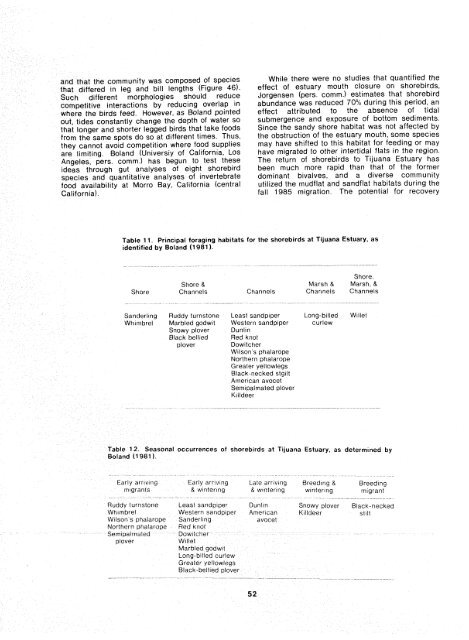The Ecology of Tijuana Estuary, California: An Estuarine Profile
The Ecology of Tijuana Estuary, California: An Estuarine Profile
The Ecology of Tijuana Estuary, California: An Estuarine Profile
Create successful ePaper yourself
Turn your PDF publications into a flip-book with our unique Google optimized e-Paper software.
-"<br />
and that the community was composed <strong>of</strong> species<br />
that differed in leg and bill lengths (Figure 46).<br />
Such different morphologies should reduce<br />
competitive interactions by reducing overlap in<br />
where the birds feed. However, as Boland pointed<br />
out, tides constantly change the depth <strong>of</strong> water so<br />
that longer and shorter legged birds that take foods<br />
from the same spots do so at different times. Thus,<br />
they cannot avoid competition where food supplies<br />
are limiting. Boland (Universiy <strong>of</strong> <strong>California</strong>, Los<br />
<strong>An</strong>geles, pers. comm.) has begun to test these<br />
ideas through gut analyses <strong>of</strong> eight shorebird<br />
species and quantltatlve analyses <strong>of</strong> ~nvertebrate<br />
food availability at Morro Bay, Californ~a (central<br />
<strong>California</strong>).<br />
While there were no studies that quantified the<br />
effect <strong>of</strong> estuary mouth closure on shorebirds,<br />
Jorgensen (pers. comm.) estimates that shorebird<br />
abundance was reduced 70% during this period, an<br />
effect attributed to the absence <strong>of</strong> tidal<br />
submergence and exposure <strong>of</strong> bottom sediments.<br />
Since the sandy shore habitat was not affected by<br />
the obstruction <strong>of</strong> the estuary mouth, some species<br />
may have shifted to this habitat for feeding or may<br />
have migrated to other intertidal flats in the region.<br />
<strong>The</strong> return <strong>of</strong> shorebirds to <strong>Tijuana</strong> <strong>Estuary</strong> has<br />
been much more rapid than that <strong>of</strong> the former<br />
dominant bivalves, and a diverse community<br />
utilized the mudflat and sandflat habitats during the<br />
fall 1985 migration. <strong>The</strong> potential for recovery<br />
Tabfe 11. Principal foraging habitats for the shorebirds at <strong>Tijuana</strong> <strong>Estuary</strong>, as<br />
identified by Boland (1 981 1.<br />
Shore.<br />
Shore & Marsh & Marsh. &<br />
Shore Chanriels Channels Charjnels Channels<br />
Sanderling Ruddy turnstone Least sandpiper Long-btlled Willet<br />
Wtiinrbrel Marbled godwtt Western sandpiper curlew<br />
Snowy plover Dunlin<br />
Black bellled Red knot<br />
plover<br />
Dow~tcher<br />
Wilson s phalarope<br />
Northern phalarope<br />
Greater yellowlegs<br />
Black-necked stg~lt<br />
American avocet<br />
Semtpalmated plover<br />
Ktlldeer<br />
- -<br />
Table 12. Seasonal occurrences <strong>of</strong> shoreb~rds at <strong>Tijuana</strong> <strong>Estuary</strong>, as deterrntned by<br />
Boland (1 981 1.<br />
Early drrlvirig Early arrsvlng Late arriving Breeding & Breedtng<br />
inigrants & wintering 8 wintcrcng w~ntertng rn~grant<br />
- * - -a- -<br />
Ruddy turnstone Least sandpiper Dunlin Snowy plover Black-necked<br />
Whimbrel Western sandpiper Arner~can Killdeer stilt<br />
Wilson s phalarope Sanderl~ng avocet<br />
Northern phalarope Red knot<br />
Sernlpdirrtaied Dciwitther<br />
plover<br />
Willet<br />
Marbled godw~t<br />
Long-billed curlew<br />
Greater yellowlegs<br />
Black-bellfed plover<br />
-- -- -- - - - - --- - - - - - .

















